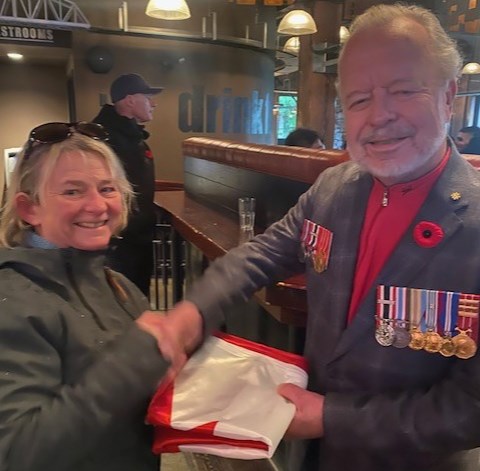Retired Army Major David Blake-Knox has taken part in Whistler’s Remembrance Day Service since 2013, and, during this year’s Colour Parade, the veteran had the distinct honour of marching directly behind a Canadian flag that flew on D-Day, one of the deadliest days of the Second World War.
Little did he know, after the ceremony concluded, the flag would be his.
“It’s poignant in that fact that it has flown on Juno Beach in Normandy,” said Blake-Knox, who splits his time between Whistler and North Vancouver. “My favourite uncle was in the Royal Canadian Army Chaplain Corps and he was there on D-Day with Bible in hand. And he actually survived the war.”
It was another Whistlerite with a personal connection to the Battle of Normandy who donated the flag to Blake-Knox. Diana De Man’s uncle, Private Walter Ratinsky, was an infantryman with The Royal Winnipeg Rifles who were part of the first wave of Allied forces to land in Normandy on June 6, 1944 under exceptionally heavy fire. Like Blake-Knox’s uncle, Ratisnky survived D-Day, fighting his way from the beaches to the countryside. A month later, he was killed as part of Operation Windsor, a Canadian attack to capture the Carpiquet airfield from German forces that many military historians today consider a failure. One hundred and 27 Canadians were killed, and 250 injured.
“It was good to learn,” said De Man, who went on a guided battlefield tour of Normandy in 2018. “My mom’s side of the family, none of them knew exactly what happened to Walter. Only one or two of them managed to go to the Canadian cemetery in France to view his headstone, but no one really knew the story.”
It was that time in Normandy, and the reception she got from locals, that inspired De Man to acquire the flag and ultimately donate it to a veteran.
“The people I met both in Juno and the other places in Normandy, when they found out I had someone who landed on the beach and fought for them, they were very thankful. But to tell them you were Canadian made the hugest difference in the world. It was an outpouring of thankfulness,” she said. “When I realized I could buy a flag and have it sent here, I wanted to make sure it went to a veteran just because the impact of meeting all those people and the gratitude they have for Canada, and the sacrifices that were made. It sticks with me, and I think it will stick with me for quite a long time.”
Blake-Knox is certainly a deserving recipient. Counting 43 years in the Canadian army and navy, he has acquired nine service medals across his long and varied military career. Over that span, postings have brought him across Canada, the Middle east, England, Germany and the U.S. He has written army policy in Ottawa, taught weapon systems maintenance, was part of the UN mission overseeing the disengagement between Syria and Israel following the Yom Kippur War, coordinated supply delivery to American troops during the Iraq War, and was the commanding officer of Vancouver’s Canadian Forces Recruiting Centre.
Approaching retirement, in 2013 Blake-Knox bought a house in Whistler, where he met his now-wife on the 7thHeaven Express. He said he intends to keep the D-Day flag in Whistler, where it was gifted to him.
“I’m keeping it flying as long as I own my home,” he said.




